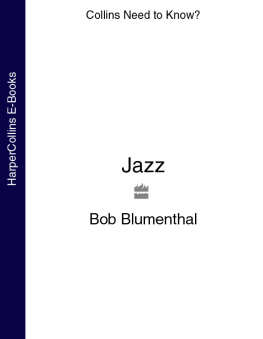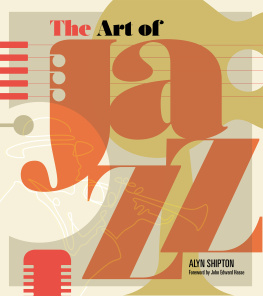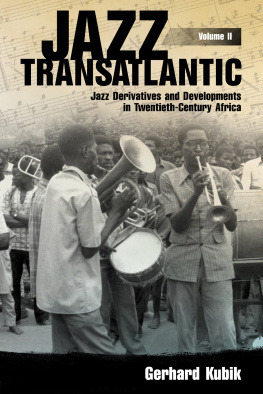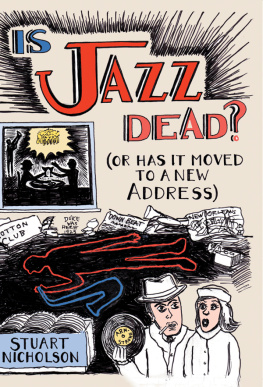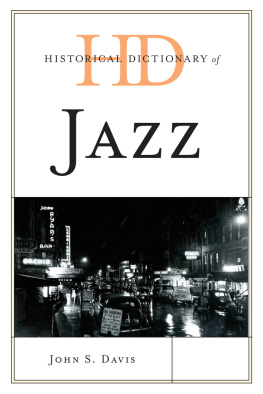

2011 Gale, Cengage Learning
ALL RIGHTS RESERVED. No part of this work covered by the copyright herein may be reproduced, transmitted, stored, or used in any form or by any means graphic, electronic, or mechanical, including but not limited to photocopying, recording, scanning, digitizing, taping, Web distribution, information networks, or information storage and retrieval systems, except as permitted under Section 107 or 108 of the 1976 United States Copyright Act, without the prior written permission of the publisher.
Every effort has been made to trace the owners of copyrighted material.
LIBRARY OF CONGRESS CATALOGING-IN-PUBLICATION DATA
Lankford, Ronald D., 1962
Jazz / by Ronald D. Lankford, Jr.
p. cm. -- (Lucent library of black history)
Includes bibliographical references and index.
ISBN 978-1-4205-0570-2 (hardcover)
1. Jazz--History and criticism. 2. African Americans--Music--History and criticism. I. Title.
ML3508.L38 2011
781.6509--dc22
2011002417
Lucent Books
27500 Drake Rd.
Farmington Hills, MI 48331
ISBN-13: 978-1-4205-0570-2
ISBN-10: 1-4205-0570-X
Printed in the United States of America
1 2 3 4 5 6 7 15 14 13 12 11

Contents
I t has been more than 500 years since Africans were first brought to the New World in shackles, and over 140 years since slavery was formally abolished in the United States. Over 50 years have passed since the fallacy of separate but equal was obliterated in the American courts, and some 40 years since the watershed Civil Rights Act of 1965 guaranteed the rights and liberties of all Americans, especially those of color. Over time, these changes have become celebrated landmarks in American history. In the twenty-first century, African American men and women are politicians, judges, diplomats, professors, deans, doctors, artists, athletes, business owners, and home owners. For many, the scars of the past have melted away in the opportunities that have been found in contemporary society. Observers such as Peter N. Kirsanow, who sits on the U.S. Commission of Civil Rights, point to these accomplishments and conclude, The growing black middle class may be viewed as proof that most of the civil rights battles have been won.
In spite of these legal victories, however, prejudice and inequality have persisted in American society. In 2003, African Americans comprised just 12 percent of the nations population, yet accounted for 44 percent of its prison inmates and 24 percent of its poor. Racially motivated hate crimes continue to appear on the pages of major newspapers in many American cities. Furthermore, many African Americans still experience either overt or muted racism in their daily lives. A 1996 study undertaken by Professor Nancy Krieger of the Harvard School of Public Health, for example, found that 80 percent of the African American participants reported having experienced racial discrimination in one or more settings, including at work or school, applying for housing and medical care, from the police or in the courts, and on the street or in a public setting.
It is for these reasons that many believe the struggle for racial equality and justice is far from over. These episodes of discrimination threaten to shatter the illusion that America has completely overcome its racist past, causing many black Americans to become increasingly frustrated and confused. Scholar and writer Ellis Cose has described this splintered state in the following way: I have done everything I was supposed to do. I have stayed out of trouble with the law, gone to the right schools, and worked myself nearly to death. What more do they want? Why in Gods name wont they accept me as a full human being? For Cose and others, the struggle for equality and justice has yet to be fully achieved.
In many subtle yet important ways the traumatic experiences of slavery and segregation continue to inform the way race is discussed and experienced in the twenty-first century. Indeed, it is possible that America will always grapple with the fallout from its distressing past. Ulric Haynes, dean of the Hofstra University School of Business has said, Perhaps race will always matter, given the historical circumstances under which we came to this country. But studying this past and understanding how it contributes to present-day dialogues about race and history in America is a critical component of contemporary education. To this end, the Lucent Library of Black History offers a thorough look at the experiences that have shaped the black community and the American people as a whole. Annotated bibliographies provide readers with ideas for further research, while fully documented primary and secondary source quotations enhance the text. Each book in the series explores a different episode of black history; together they provide students with a wealth of information as well as launching points for further study and discussion.

The Birth of an American Art Form
O f all the cultural contributions made by African Americans in the United States, jazz rates as one of the greatest. Born in the bars and bordellos of New Orleans during the 1890s, jazz has evolved into a poetic musical form welcomed in fine art centers in cities such as New York, Los Angeles, and Washington, D.C. Once performed by untrained musicians who were unable to read transcribed music, jazz is now taught in prestigious conservatories and colleges.
Jazz has also traveled far beyond the borders of the United States. Even early in its development, American jazz found a warm reception in Europe; today, jazz is embraced all over the world, from Stockholm, Sweden, to Cape Town, South Africa. As an African American art form, jazz is part of a tradition that continues to enrich both the United States and cultures around the world in the present.
Trying to understand how jazz has influenced and intertwined with American culture is not easy. Over time, jazz has seeped into many areas of American life and has taken many forms, including live performances in nightclubs and at high school events, recordings on the radio, and jazz soundtracks on television and in the movies. It is difficult to remember a time when jazz was new and sometimes controversial.
Arguably, jazz has played a central role in the development of American culture.
Often, jazz allowed African Americans an avenue for artistic expression within a larger society that suppressed black creativity. In a variety of ways, jazz has also helped to negotiate race relations in the United States, allowing blacks, whites, and many other races a neutral ground to learn about one another. Even while jazz was initially associated with African Americans, jazz has become part of the social fabric for all Americans. Jazz was born over a hundred years ago, but it remains a living legacy, both in the United States and around the world.
Artistic Expression and Freedom
During the late 1800s, when jazz was first being formed from blues, folk music, and ragtime, many African Americans were treated as second-class citizens in the United States. While slavery had officially ended with the Civil War, many Southern states continued to restrain the freedom of blacks through oppressive laws. Known as Jim Crow laws, these rules robbed African Americans of many basic rights, including the freedom to vote. Many of these laws supported a separate but equal philosophy, and enforced racial segregation. Under these laws, blacks and whites attended different schools, ate at different restaurants, and rode on separate train cars. Although separate, the facilities for African Americans were seldom equal.
Next page


